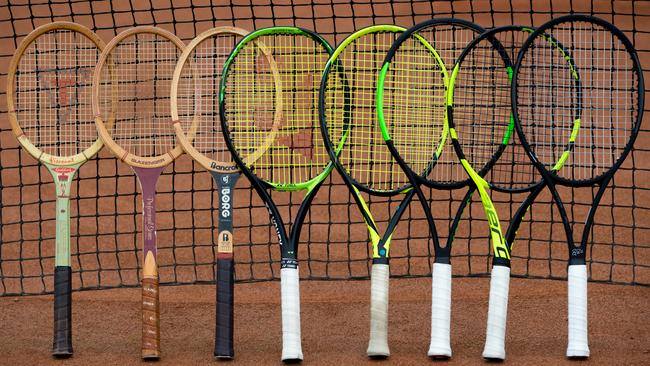The bazooka Nadal will use to defend French crown
A player’s tennis racquet tells you plenty about how they play, especially if you’re Rafael Nadal or Roger Federer.

Rafael Nadal will attempt to win an 11th French Open with a bazooka in his hand.
An agreeable and downright fascinating afternoon was spent hitting balls at the National Tennis Centre in January with the frames used by Nadal, Roger Federer, Alexander Zverev, Nick Kyrgios, Daria Gavrilova, Venus Williams, Bjorn Borg, Jimmy Connors, Arthur Ashe and Rodney George Laver.
The Racquet Room at Melbourne Park has a court decked out for the statistical analysis of a racquet’s characteristics and yet you didn’t need the data to know Nadal’s stick had a life of its own. Electrifying power. Minimal control. A little kid’s grip size. Volatile strings. He’s a naturally defensive player who needs an aggressive racquet. Federer is an attacking player who needs extra feel and control. Nadal would get blown off the court with Federer’s stick in his hands. Federer would spray balls into the next postcode with Nadal’s.
The Racquet Room is the next phase of tennis technology.
It’s an initiative of the Game Insight Group, which is a partnership between Tennis Australia and Victoria University. Custom-made golf clubs are the norm. Why not tennis racquets? That’s the idea of it, and it opens to the public on July 2.
Sensors in and around the court record power, control and spin. At the end of the session, the computer crunches the numbers and recommends a model. It’s heaven for the enthusiast. And revelatory when it comes to Nadal and Federer.
The difference between most of the modern-day sticks was minimal. Power versus control was the crux of every judgment. Stiffness versus flexibility. Light versus heavy. Laver’s old Dunlop Maxply Fort was beautiful. All feel and grace. Stuff-all power. Federer’s slim graphite Wilson Pro Staff RF97 was as close as you could get to the control of the old wooden number. It required more skill. You had to hit it great for it to come off great. Power was self-generated. You stroked through the ball with Federer’s weapon of choice. You clubbed it to death with Nadal’s.
The ball machine was feeding short groundstrokes. I hit a full-blooded forehand with Nadal’s frame. It rocketed halfway up the back fence. The same swing with the Federer and Laver racquets had put the ball where it was meant to go.
Nadal uses the Babolat Pure Aero. It was like holding a light sabre. It was lighter than Federer’s, allowing more whip. A bigger head made it more forgiving on mis-hits.
Placement was at a premium with Federer’s racquet. A rolling topspin, crisp slice. Beautiful.
The only way to keep Nadal’s racquet under control was to unload with ferocious topspin. Only then did it start to hit the mark. But it was an exhausting exercise, however, without Nadal’s strength of wrist, forearm, bicep and shoulder.
Victorian University researcher Damian Farrow said: “Roger’s game style revolves around maintaining super-aggressive court positioning.
“Accordingly, Roger’s preference is for control and feel, which he gains through a less stiff racquet with a smaller head size.
“His addition of natural gut in the main strings also increases feel and power to some extent, but at the cost of less spin. It’s worth noting that in 2014 he did shift to a larger head size for more power in an attempt to match the modern big-hitting game. He suggests it’s benefited his backhand the most.
“Clearly beneficial now, it also highlights how a racquet as powerful as Rafa’s would likely be counterintuitive for Roger’s aggressive game style.”
Nadal’s loaded racquet was topped up with the most explosive type of string, the Babolat RPM Blast. Why? He needs this stuff. His serve would be too slow and ineffective without it. He’s a counter-puncher. His equipment provides a lot of the punch. It turns a fantastic forehand into a frightening one. His left wrist makes an almighty snap right before contact with the ball. He has a small grip at 4-1/8 inches. That’s the size you get on junior racquets. The smaller the grip, the more you can flick the racquet around if you have the strength.
The roundhouse wind-up to Nadal’s forehand and the lasso follow-through comes from the extreme cocking and release of the wrist, on a tiny grip, before the light frame is whipped through. He has a bigger forearm than Popeye. He needs it.
Nadal himself doesn’t unleash a lot of power through the ball. There’s a tonne of spin over the ball. Without the bazooka, he would be marginally less dangerous while scampering around near the back fence. The Racquet Room revealed a lot about the equipment — and the players who use them. The Pro Staff RF 97? For experienced players only. The Babolat Pure Aero? A beginner’s dream.













To join the conversation, please log in. Don't have an account? Register
Join the conversation, you are commenting as Logout